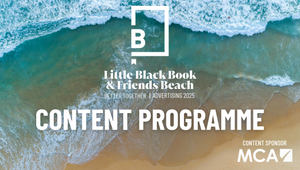
Cannes Lions 2035: Creativity at the Edge of Everything

Ten years ago in 2025, we were asking if AI would kill creativity.
This year, we asked if creativity might be the only thing that saves us.
Cannes Lions 2035 wasn’t about hype. It was about heat. Economic. Climatic. Cultural.
And the sense that creativity has hit a point of no return.
AI is now ambient. Deepfakes are daily. Marketing automation is full-stack and mostly hands-free. So, Cannes didn’t ask “what’s next.” It asked, “what now?”
Here’s what stood out - clearly, sharply, and with zero jargon.
1. Ownership Got a Rewrite
Every entry this year had to list how it was made:
Human-led. AI-assisted. AI-dominant.
Welcome to the Creative Provenance Protocol—Cannes' new standard for authorship in the AI era. It’s not optional. It’s required.
This wasn’t just compliance. It marked a new era.
Agencies now license IP. Creatives get royalties. Rights aren’t just legal—they’re creative leverage.
Authorship didn’t die. It evolved—and got a lawyer.
2. Synthetic Media Got Rules
By 2035, synthetic content is standard. Voice, image, video—mostly machine-made.
But the big shift? It’s now audited.
Cannes demanded proof: where the data came from, who gave consent, and how it was used. No receipts, no shortlist.
A new category - Best Synthetic Integrity - rewarded campaigns that used AI with accountability, not shortcuts.
Anyone can fake it. Trust is the new creative currency.
3. Emotional Targeting Got a Whole New Meaning
You’re not just being targeted by behaviour anymore - you’re being read.
Thanks to emotion-sensing wearables and ambient tech, campaigns now adapt in real-time to your mood. Change how you feel? The ad changes too.
Forget personalisation. This is emotional choreography.
New rule: Right feeling. Right moment.
4. Screens Are Dying. The World Is the Medium.
One of the biggest winners didn’t run on a screen. It was the screen.
A city block turned into a live story using scent, sound, and light - no devices, no downloads.
This is spatial media. Environments that respond to you.
If your campaign still lives in rectangles, you’re thinking too small.
5. Neural Interfaces Are Real. Just Not Ready.
Yes, we saw brain-controlled campaigns.
No, they’re not mainstream yet.
But they’re coming. And they’ll change how we define 'engagement.' Because when a thought can launch a brand experience, everything changes - again.
6. The Work Is Made by Humans, AI Agents, and Something In-Between
Most campaigns this year? AI-built. Insight to idea to execution. Fully autonomous.
These aren’t tools. They’re teammates. Trained on brand data. Tied into performance.
Running 24/7.
The human role? Smaller. But sharper.
Creative direction now means shaping systems, not just headlines.
7. Agencies Sell Systems - But So Do Platforms
Agencies now license branded AI - creative engines trained on their own work.
Clients don’t brief. They subscribe.
But the competition is fierce. Platforms like Meta, Amazon, and TikTok now offer full-stack creative solutions - faster, cheaper, and fully automated.
To stay relevant, creative companies must shift from integrating tools to inventing them - building proprietary engines, owning IP, and operating at platform speed.
In 2035, you’re not pitching. You’re programming.
8. Data Insights Are Extracted in Different Ways
Data privacy laws killed cookies, banned biometric targeting, and shut down AI profiling.
So, data is no longer the end-all and be-all of campaigns.
What’s gaining influence?
Context. Creativity. And actual ideas.
Turns out when you can’t track people, you have to move them.
9. Culture Now Has a Synthetic Twin
AI doesn’t just support culture. It creates it.
Machine-made memes. AI-generated music. Algorithmic trends. All mainstream now.
If your brand can’t play inside synthetic culture, you’re already lagging.
Oh - and campaigns are now being co-created by fans, DAOs, and GPTs.
Story ownership is shared. Credit is fluid. Remixing is the default.
10. The Vibe Shift Is Real
Cannes was quieter this year. Not sombre - just sober.
The biggest draw wasn’t a unicorn founder. It was a neuroscientist talking about creative burnout in the age of always-on stimuli.
Sessions weren’t about “reach.” They were about resonance, responsibility, and recovery.
The work is still beautiful. But now it also has to matter.
And 2045?
If 2025 was automation, and 2035 is adaptation…
2045 will be assimilation.
No more interfaces. Just experiences.
No more formats. Just environments.
No more audiences. Just participants.
The next generation of creatives won’t just make content.
They’ll shape systems.
Design realities.
Program cultural behaviour.
And the real work won’t be about telling better stories.
It will be about building the worlds they can live in.
Anthony Yell is chief creative officer at Razorfish.















